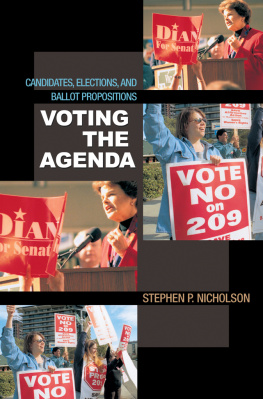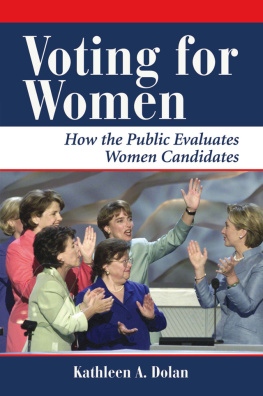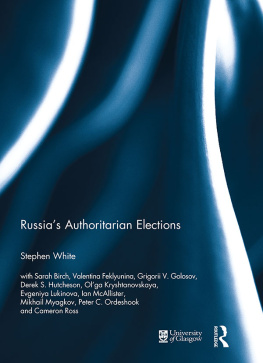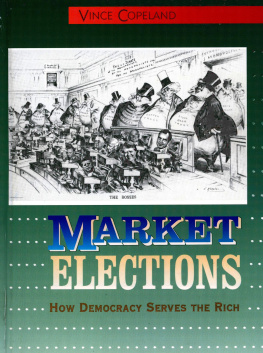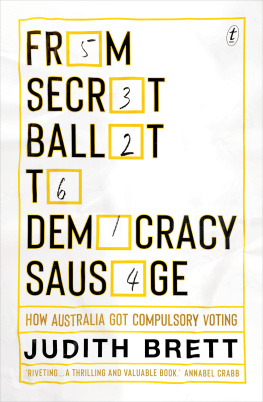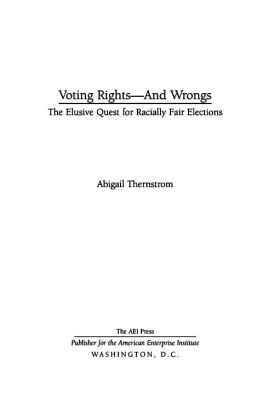Copyright 2005 by Princeton University Press
Published by Princeton University Press, 41 William Street,
Princeton, New Jersey 08540
In the United Kingdom: Princeton University Press,
3 Market Place, Woodstock, Oxfordshire OX20 1SY
All Rights Reserved
Library of Congress Cataloging-in-Publication Data
Nicholson, Stephen P., 1966
Voting the agenda : candidates, elections, and ballot
propositions / Stephen P. Nicholson
p. cm.
Includes bibliographical references and index.
ISBN: 0-691-11684-9 (cloth : alk. paper)
eISBN: 978-0-69122-384-1 (ebook)
1. ElectionsUnited States. 2. VotingUnited States. 3. Direct
democracyUnited States. 4. Political psychology. I. Title.
JK1976.N47 2005
324.973dc22 2004042189
British Library Cataloging-in-Publication Data is available
R0
PREFACE
A s a graduate student living in California, I found a marked disjuncture between what I was learning about congressional and gubernatorial elections in the scholarly literature and what I learned about them from watching television, reading the newspaper, and talking to people in and outside of academia. I found that scholarly accounts of voting and elections focused on particular types of electoral contests (e.g., House elections) and factors exclusive to them such as the candidates party affiliations, campaigns, and issues. With the exception of national issues such as the economy or approval of the president, the larger political environment of issues seemed to be shortchanged. National issues are important, of course. Nonetheless, they only partly define the bustling marketplace of elections. In many states, to anticipate the argument of this book, ballot measures play an important role. Nowhere is this more conspicuous than in California, where ballot propositions regularly define the electoral agenda. Is this a unique feature of California politics, or do initiatives and referenda play an important role in other states elections? If they do, what does that mean for traditional approaches to the study of voting for congressional and state offices? Are scholars missing an important piece of the electoral puzzle?
Although salient ballot measures certainly do not play an important role in each election cycle of every state, they do appear regularly in many of them. In addition, ballot propositions could well be the proverbial tip of the iceberg. States have an electoral environment all their own, driven by high-profile candidate contests and news media. Surely, the issues from these sources define agendas. But the difficult case is ballot measures, which are by definition restricted to state policy. Students of congressional elections, for example, do not consider ballot measures because, the logic goes, voters do not connect state issues to federal races. Besides, congressional candidates probably ignore these issues, further dampening the prospects for a relationship between the two.
Yet a major theme of most scholarly work on voting and elections is that the typical voter lacks a sophisticated understanding of politics. If so, we would hardly expect most voters to fine-tune their voting decisions to match the job responsibilities of particular offices. Nor would we expect them to match issues judiciously to the contests from which they came. Instead, we would anticipate that most voters draw heavily from the information environment in the form of the electoral agenda to which they are exposed.
Voters absorb the agenda. Should the issues on it have a partisan bent, it seems reasonable that they would apply the same issue understanding of the election across a variety of offices. Thus, we expect that voters go to the polls with a Democratic or Republican Party mindset, primed to evaluate candidates with issues favorable to a party. Incumbency, name recognition, party identification, and other factors strongly associated with voting surely continue to figure prominently, but something big is missing from many accounts of nonpresidential elections. My purpose in this book is to direct attention to this missing element in standard accounts by focusing on the essential features of the larger political environment within which elections take place and voters make decisions.
I have many people to thank for helping me with this book. To begin with those closest to the project, I thank Bob Jackman and Gary Segura. Bob and Gary provided valuable comments and suggestions from which this project greatly benefited both as a dissertation and as the book before you. My debts to Gary and Bob extend beyond helping me with this project, however. Both were especially important in helping me develop as a scholar. I have learned a great deal from them, and I am in their debt. Their enthusiasm for the study of elections and voting behavior is contagious.
Gary gave a first-year graduate student without any direction other than, I want to study American politics, much-needed guidance. After speaking with him at a department barbeque before my first year of graduate work, I worked for him as a research assistant. Although he called me about research projects long before I would have ordinarily gotten up in the morning, I am grateful to him for giving me direction and impressing on me the value of conducting strong theoretical and empirical research (and getting it done!). Although Gary left UCDavis before I was very far along on my dissertation research (he stayed just long enough to tell me that my first idea was too small), he continued to give me significant feedback. I am grateful to him for these things as well as continuing to be a valued friend and coauthor.
Bob probably read more chapters of this manuscript than anyone else (and more than he cares to think about, Im sure). He read, reread, and reread yet again many drafts. Many of these early drafts came back in a sea of red ink, something that he may not know he is (in)famous for among UCDavis graduate students. But my recidivism was driven by the care he took in responding to my ideas and helping me strengthen their exposition. I am grateful for his continued support and friendship.
Gary Jacobson and Scott James also helped shape this project, and I am indebted to them as well. Although at UCSD, Gary was kind enough to serve as a member of my dissertation committee. He offered valuable comments on theory and empirical models, especially the need to focus the project. His deep understanding of congressional elections was also valuable. Before he left UCDavis, Scott and I had marathon-long conversations about my ideas that were critical to moving me in the direction of studying ballot initiatives and congressional elections. But more than that, he suggested that I get outside the literature now and again because he saw it hindering my theory buildinghis nudging encouraged me to do just that, and the book is much better for it. Scott also slugged through multiple drafts of , both during the writing of the dissertation and long afterward, when I was revising it for publication.
I also extend a hearty thanks to the following people for providing comments on one or more chapters: Monica Barczack, Shaun Bowler, Dave Damore, Jamie Druckman, Stacy Gordon, Jennifer Jerit, Peter Lindsay, Jennifer Nicholson, Dave Nixon, Dave Redlawsk, and Roger Rose. I am also grateful to the anonymous reviewers at Princeton University Press who provided feedback that led to important changes in clarifying my argument and improving the presentation of results. In addition, conversations with Jo Andrews, Scott Gartner, Elisabeth Gerber, Scott Graves, Tom Hansford, Stuart Hill, Brian Lawson, Ross Miller, Randolph Siverson, Jim Spriggs, and Nayda Terkildsen were helpful in many different ways. Edmond Costantini also helped write the questions we submitted to the Field Poll and acted as the faculty sponsor. All of these people provided valuable comments that helped strengthen the project, sometimes considerably so.

